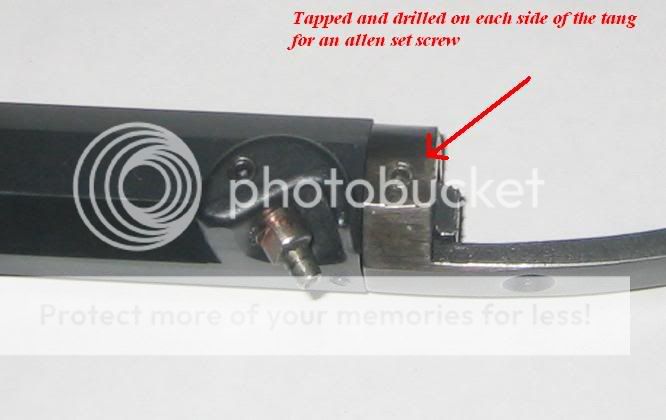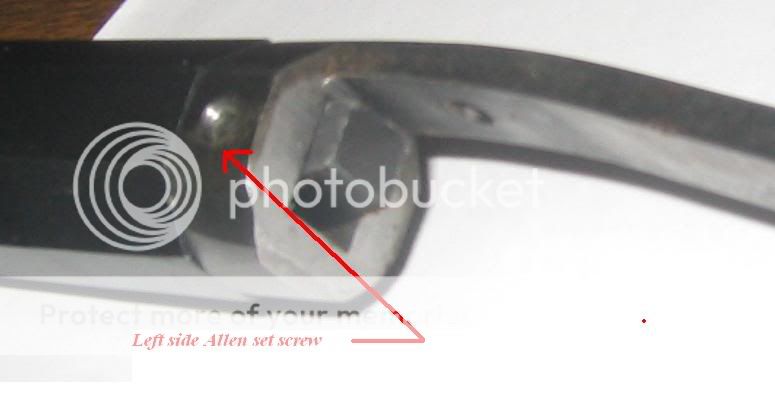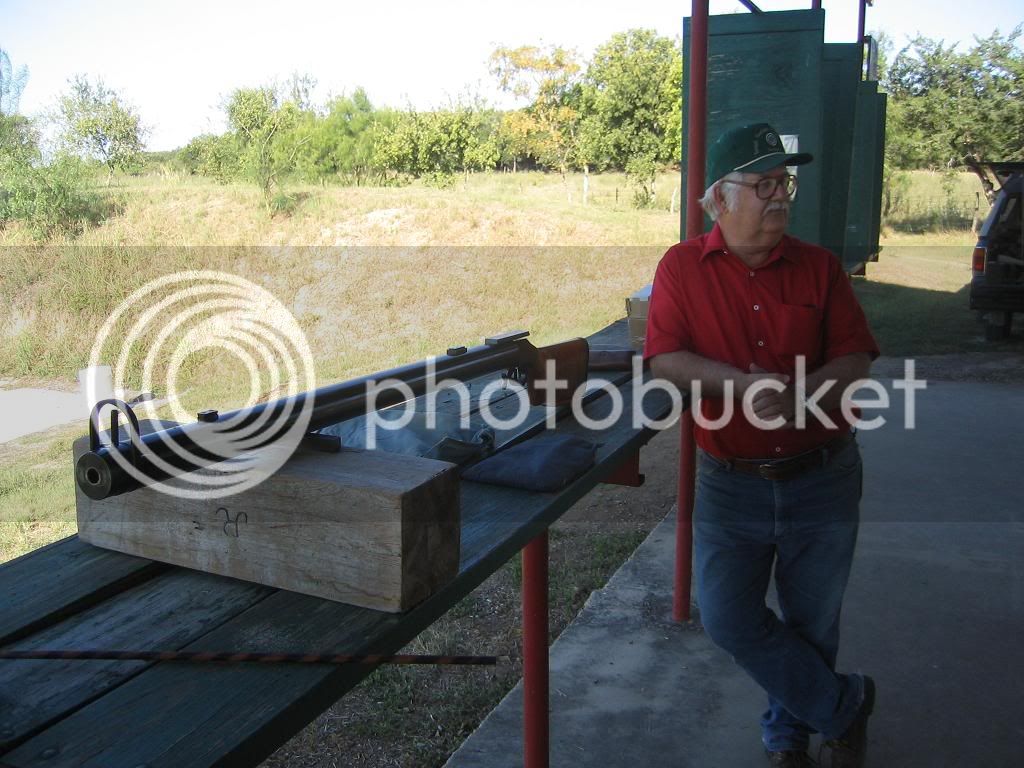JOHN L. HINNANT
45 Cal.
- Joined
- May 29, 2004
- Messages
- 711
- Reaction score
- 2
Greetings BLAHMAN, FW, Walruskid1 and All,
I have not looked at a T-C sight in some time now and really do not have any basis to give you an honest opinion, however T-C puts out quality merchandise, so I would have to think it is good.
The same thing about Fred,s H&A sight, and Fred I never laugh at, make fun, or disparage another mans equipment. My parents would not allow that type of behavior. Besides the old timers used equipment that was pretty crude compared to what we have available to us today, and they did a very good job of shooting.
One of the all time great offhand shooters at Friendship shoots the most awful looking rifle you can imagine I swear the stock is a Civil War musket type,and the flintlock is a big slow affair. Sights are on a par with the rest of the rifle. The barrel was the best he could buy; at that time a Hopkins H & H, and he shot only 45 caliber. With this rig, all he did was shot 10's when he was not shooting X's. It is the only rifle he shoots (may be the only one he owns) and even shoots it inthe cross sticks and bench matches. The X-stiks AND bench rest boys tend to get a bit nervous when he goes to shoot against them.
The thimbles are long gone from his musket stock, and one year somebody filed a rules violation complaint against him because his stock did not have any thimbles to hold a ramrod. The rules stated that for a particular event, the rifle must be capable of securing a ramrod. The stock did have a ramrod hole, so the question was borderline. I walked in to the lunch room at the range, and there sat the gentleman with rifle in question. He had gone over to Traders Row, purchased a thimble. He was using his pocket knife to cut a slot in the stock for a thimble and then installed it with a couple of wraps of duct tape. He then proceeded back to the range to shoot more 10's and X's. My kind of guy.
Can we improve on equipment and learn from the pro's? you bet we can. My equipment, techniques, and overall knowledge are vastly improved over what I learned in the 50's, 60's, and early 70's. And it can be attributed to friends like Frank Collins, Alex Hamilton, and several others.
For instance, when shooting the rifles that have a seperate barrel and action like the under hammer type of anybodys make, mounting a rear sight on the action and a front sight on the barrel is not the best arrangement. Eventually the two components will loosen and that pin-point accuracy will deterioate badly. The same thing can be said of mounting a sight on the tang of a T-C.
ALL OF you T-C owners pick up your rifle ad gently twist the barrel. If there is any play between the the tang ang hook breech, you will detect it. Developing and/or maintaining a high level of accuracy with a sight mounted on the tang is going to be very difficult, if not impossible. This will be true of any Hawken style hook breech and tang design.
With the T-C, this "play" can be greatly minimized by installing and using the set screw method in the photographs posted by Davy elsewhere on the forum. Others like my Santa Fe Hawken have to be epoxied together.
A good friend, and many time TMLRA STATE CHAMPION, was occassionly plaqued by a flyer(s) at the worst time. He would go along shooting X's with his Ken Bresien bench rifle and then a 9 or barely close 10. Two 1/4 - 28 NF machine screws through the action tighten to the breech plug tang, holding the two together. Regardless of how tight the screws were, there was always flexing between the action and barrel. Whenever, Pancho got into shooting position on the bench, you could see traces of oil being squeezed out of the junction of the barrel and action.
When the old barrel finally died, the new barrel was set up with a long sight bar fiited to the barrel, and the rear Redfield sight mounted on the sight bar. With this arrangement, all sights are mounted on the barrel, and so what if there was flexing between the action and the barrel. This sight mounting method also allows the interchangeability of barrels (provided there is a separate sight bar on each barrel) with a minimal loss of sight zero.
Evenually Fred, you will probably have to go to this type of sight system, paticularly if you want to use you H&A action as a base for a switch barrel rifle. In the meantime, until and if the play between the barrel and action developes, shoot away and have great fun.
The Ithaca Hawken is an entirely different matter. In my opinion, this is a rifle that should be left unaltered. Any alterations will adversely affect the value of a truely fine arm. This is a hunting rifle and one that can be used for the matchs where a tradition styled rifle with open sights is required.
So far as the question about Teflon coated patching goes, I and others have posted much about this subject; both pro and con. This discussion is already on the forum if you want to look it up.
By the way Frank, thank you for the accolades about winning, but it is not quite that way. I do not compete in as many aggs, as I used to. The stamina for that much shooting is simply no longer there. In addition, I am not a natural born rifle shot. Quite the contrary, I have to work very hard with much practice to win anything at all.
Between 1984 and 1988, I would place around 5th OR 6th place for the TMLRA State Championship, while winning or placing in other aggs. In 1989, I decided to go all out for the championship. I had the equipment; the missing component was me.
On February 1, 1989, I started on a physical training program that involved shooting, body conditioning and a proper diet. One or more of these activities was involved every day. For example, I was at the range three days a week practicing offhand shooting at the proper 25 and 50 yard targets. The other days, practice was with an air rifle at reduced size targets in my back yard.
I did win the 1989 TMLRA State Championship. but at a price. Time was taken away from my family. Other enjoyable activities were ignored. All in all, afterwards I questioned if all of the work was really worth it. I decided that if this much work (and it was work) was required of me to win the state championship again, it was not worth the stress and neglect my family experienced and would again. Since 1989, I have not entered the State Championship event. It is enough to go each year, visit with friends, and shoot in two or three events that do not run up my stress factor.
As a side note and something of a more personal nature. When my old mentor. Judge H. E. Resley won the TMLRA STATE CHAMPIOSHIP, it was in 1949, and he was 50 years old. I was 50 years in 1989.
It is time for me to head to bed. Need to be up and moving in the morning. My youngest (a daughter)
graduates at 9:00 in the morning from UTSA. Now, THAT is an accomplishment.
Best regards and good shooting,
John L. Hinnant
If you are not an NRA Member, why not? I am carrying your load.
John L. Hinnant
I have not looked at a T-C sight in some time now and really do not have any basis to give you an honest opinion, however T-C puts out quality merchandise, so I would have to think it is good.
The same thing about Fred,s H&A sight, and Fred I never laugh at, make fun, or disparage another mans equipment. My parents would not allow that type of behavior. Besides the old timers used equipment that was pretty crude compared to what we have available to us today, and they did a very good job of shooting.
One of the all time great offhand shooters at Friendship shoots the most awful looking rifle you can imagine I swear the stock is a Civil War musket type,and the flintlock is a big slow affair. Sights are on a par with the rest of the rifle. The barrel was the best he could buy; at that time a Hopkins H & H, and he shot only 45 caliber. With this rig, all he did was shot 10's when he was not shooting X's. It is the only rifle he shoots (may be the only one he owns) and even shoots it inthe cross sticks and bench matches. The X-stiks AND bench rest boys tend to get a bit nervous when he goes to shoot against them.
The thimbles are long gone from his musket stock, and one year somebody filed a rules violation complaint against him because his stock did not have any thimbles to hold a ramrod. The rules stated that for a particular event, the rifle must be capable of securing a ramrod. The stock did have a ramrod hole, so the question was borderline. I walked in to the lunch room at the range, and there sat the gentleman with rifle in question. He had gone over to Traders Row, purchased a thimble. He was using his pocket knife to cut a slot in the stock for a thimble and then installed it with a couple of wraps of duct tape. He then proceeded back to the range to shoot more 10's and X's. My kind of guy.
Can we improve on equipment and learn from the pro's? you bet we can. My equipment, techniques, and overall knowledge are vastly improved over what I learned in the 50's, 60's, and early 70's. And it can be attributed to friends like Frank Collins, Alex Hamilton, and several others.
For instance, when shooting the rifles that have a seperate barrel and action like the under hammer type of anybodys make, mounting a rear sight on the action and a front sight on the barrel is not the best arrangement. Eventually the two components will loosen and that pin-point accuracy will deterioate badly. The same thing can be said of mounting a sight on the tang of a T-C.
ALL OF you T-C owners pick up your rifle ad gently twist the barrel. If there is any play between the the tang ang hook breech, you will detect it. Developing and/or maintaining a high level of accuracy with a sight mounted on the tang is going to be very difficult, if not impossible. This will be true of any Hawken style hook breech and tang design.
With the T-C, this "play" can be greatly minimized by installing and using the set screw method in the photographs posted by Davy elsewhere on the forum. Others like my Santa Fe Hawken have to be epoxied together.
A good friend, and many time TMLRA STATE CHAMPION, was occassionly plaqued by a flyer(s) at the worst time. He would go along shooting X's with his Ken Bresien bench rifle and then a 9 or barely close 10. Two 1/4 - 28 NF machine screws through the action tighten to the breech plug tang, holding the two together. Regardless of how tight the screws were, there was always flexing between the action and barrel. Whenever, Pancho got into shooting position on the bench, you could see traces of oil being squeezed out of the junction of the barrel and action.
When the old barrel finally died, the new barrel was set up with a long sight bar fiited to the barrel, and the rear Redfield sight mounted on the sight bar. With this arrangement, all sights are mounted on the barrel, and so what if there was flexing between the action and the barrel. This sight mounting method also allows the interchangeability of barrels (provided there is a separate sight bar on each barrel) with a minimal loss of sight zero.
Evenually Fred, you will probably have to go to this type of sight system, paticularly if you want to use you H&A action as a base for a switch barrel rifle. In the meantime, until and if the play between the barrel and action developes, shoot away and have great fun.
The Ithaca Hawken is an entirely different matter. In my opinion, this is a rifle that should be left unaltered. Any alterations will adversely affect the value of a truely fine arm. This is a hunting rifle and one that can be used for the matchs where a tradition styled rifle with open sights is required.
So far as the question about Teflon coated patching goes, I and others have posted much about this subject; both pro and con. This discussion is already on the forum if you want to look it up.
By the way Frank, thank you for the accolades about winning, but it is not quite that way. I do not compete in as many aggs, as I used to. The stamina for that much shooting is simply no longer there. In addition, I am not a natural born rifle shot. Quite the contrary, I have to work very hard with much practice to win anything at all.
Between 1984 and 1988, I would place around 5th OR 6th place for the TMLRA State Championship, while winning or placing in other aggs. In 1989, I decided to go all out for the championship. I had the equipment; the missing component was me.
On February 1, 1989, I started on a physical training program that involved shooting, body conditioning and a proper diet. One or more of these activities was involved every day. For example, I was at the range three days a week practicing offhand shooting at the proper 25 and 50 yard targets. The other days, practice was with an air rifle at reduced size targets in my back yard.
I did win the 1989 TMLRA State Championship. but at a price. Time was taken away from my family. Other enjoyable activities were ignored. All in all, afterwards I questioned if all of the work was really worth it. I decided that if this much work (and it was work) was required of me to win the state championship again, it was not worth the stress and neglect my family experienced and would again. Since 1989, I have not entered the State Championship event. It is enough to go each year, visit with friends, and shoot in two or three events that do not run up my stress factor.
As a side note and something of a more personal nature. When my old mentor. Judge H. E. Resley won the TMLRA STATE CHAMPIOSHIP, it was in 1949, and he was 50 years old. I was 50 years in 1989.
It is time for me to head to bed. Need to be up and moving in the morning. My youngest (a daughter)
graduates at 9:00 in the morning from UTSA. Now, THAT is an accomplishment.
Best regards and good shooting,
John L. Hinnant
If you are not an NRA Member, why not? I am carrying your load.
John L. Hinnant









